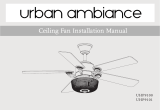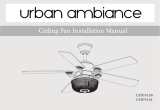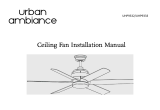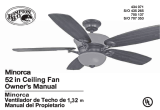
1. Para disminuir el riesgo de descarga eléctrica, antes de comenzar
la instalación asegúrate de que la electricidad ha sido cortada en el
cortacircuitos o en la caja de fusibles.
2. Todo el cableado tiene que cumplir con el Código Nacional de Electricidad
ANSI/NFPA 70-1999 y los códigos eléctricos locales. La instalación
eléctrica debe hacerse por un electricista calicado con licencia.
3. CUIDADO: Para reducir el riesgo de lesiones físicas, usa sólo los
tornillos suministrados con la caja de distribución.
4. La caja eléctrica y estructura de soporte tienen que montarse de
forma segura para poder sostener con conanza 35 lb (15.9 kg).
Usa solo cajas eléctricas aprobadas por cUL y marcadas como
“Aceptable para sostener ventiladores de 35 lb (15.9 kg) o menos.”
5. CUIDADO: El ventilador tiene que montarse con al menos 7 pies
(2.13 m) de separación entre el borde trasero de las aspas y el piso.
6. No esperes a que el ventilador se detenga antes de presionar el
botón de reversa. Si el ventilador no está en movimiento, no
cambiará de dirección.
7. Evita colocar objetos en la trayectoria de las aspas.
8. Para evitar lesiones personales o daños al ventilador y otros
artículos, ten cuidado al limpiarlo o al trabajar cerca de él.
9. No usar agua ni detergentes para limpiar el ventilador o las
aspas. Para limpiar, casi siempre será adecuado un paño seco o
ligeramente humedecido con que quitar el polvo.
10. Después de concluir con las conexiones eléctricas, debes voltear
los conductores empalmados hacia arriba y empujarlos con
cuidado hacia dentro de la caja de distribución. Los cables deben
estar separados, con el cable y el conductor a tierra del equipo
hacia uno de los lados de la caja eléctrica y el conductor sin
conexión a tierra hacia el lado opuesto.
11. Los diagramas eléctricos son sólo para referencia. Los kits de luces
no empaquetados con el ventilador tienen que estar aprobados
por UL y marcados como apropiados para usar con el modelo de
ventilador que estás instalando. Los interruptores tienen que estar
clasicados de uso general por UL. Para ensamblar bien, consulta
las instrucciones adjuntas a los kits de luces e interruptores.
12. Antes de la instalación, todos los tornillos de jación tienen que
comprobarse y reajustarse donde sea necesario.
13. PRECAUCIÓN: Para reducir el riesgo de incendio o descarga
eléctrica, este ventilador sólo debe ser usado con un control de
velocidad del ventilador DP-5R, fabricado por DAWNSUN
ELECTRONIC TECHNOLOGY CO LTD ZHONGSHAN.
14. Puede usarse en lugares húmedos. Usar solo con kits de luces
marcados como “Adecuado para uso en lugares húmedos".
1. Normas de seguridad
LEE Y GUARDA ESTAS INSTRUCCIONES
PARA REDUCIR EL RIESGO DE INCENDIO, DESCARGA ELÉCTRICA
U OTRAS LESIONES, INSTALA SÓLO EN UNA CAJA ELÉCTRICA
CLASIFICADA COMO “APROPIADA PARA SOSTENER VENTILADORES
DE 35 LB (15.9 KG) O MENOS”, Y USA SÓLO LOS TORNILLOS
INCLUIDOS CON LA CAJA ELÉCTRICA.
PARA REDUCIR EL RIESGO DE LESIONES PERSONALES, NO DOBLES
LOS BRAZOS DE LAS ASPAS (TAMBIÉN LLAMADOS “REBORDES”) NI
DURANTE NI DESPUÉS DE LA INSTALACIÓN. NO COLOCAR OBJETOS
EN LA TRAYECTORIA DE LAS ASPAS.
PARA EVITAR EL RIESGO DE DESCARGA ELÉCTRICA, ESTE
VENTILADOR DEBE SER INSTALADO CON UN CONTROL/
INTERRUPTOR DE AISLAMIENTO DE MONTAJE EN PARED.





























